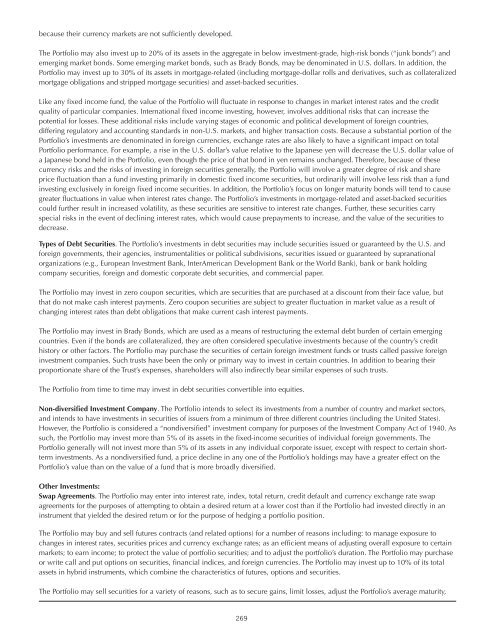Advanced Series Trust AST Academic Strategies Asset ... - Prudential
Advanced Series Trust AST Academic Strategies Asset ... - Prudential
Advanced Series Trust AST Academic Strategies Asset ... - Prudential
You also want an ePaper? Increase the reach of your titles
YUMPU automatically turns print PDFs into web optimized ePapers that Google loves.
ecause their currency markets are not sufficiently developed.<br />
The Portfolio may also invest up to 20% of its assets in the aggregate in below investment-grade, high-risk bonds (“junk bonds”) and<br />
emerging market bonds. Some emerging market bonds, such as Brady Bonds, may be denominated in U.S. dollars. In addition, the<br />
Portfolio may invest up to 30% of its assets in mortgage-related (including mortgage-dollar rolls and derivatives, such as collateralized<br />
mortgage obligations and stripped mortgage securities) and asset-backed securities.<br />
Like any fixed income fund, the value of the Portfolio will fluctuate in response to changes in market interest rates and the credit<br />
quality of particular companies. International fixed income investing, however, involves additional risks that can increase the<br />
potential for losses. These additional risks include varying stages of economic and political development of foreign countries,<br />
differing regulatory and accounting standards in non-U.S. markets, and higher transaction costs. Because a substantial portion of the<br />
Portfolio’s investments are denominated in foreign currencies, exchange rates are also likely to have a significant impact on total<br />
Portfolio performance. For example, a rise in the U.S. dollar’s value relative to the Japanese yen will decrease the U.S. dollar value of<br />
a Japanese bond held in the Portfolio, even though the price of that bond in yen remains unchanged. Therefore, because of these<br />
currency risks and the risks of investing in foreign securities generally, the Portfolio will involve a greater degree of risk and share<br />
price fluctuation than a fund investing primarily in domestic fixed income securities, but ordinarily will involve less risk than a fund<br />
investing exclusively in foreign fixed income securities. In addition, the Portfolio’s focus on longer maturity bonds will tend to cause<br />
greater fluctuations in value when interest rates change. The Portfolio’s investments in mortgage-related and asset-backed securities<br />
could further result in increased volatility, as these securities are sensitive to interest rate changes. Further, these securities carry<br />
special risks in the event of declining interest rates, which would cause prepayments to increase, and the value of the securities to<br />
decrease.<br />
Types of Debt Securities. The Portfolio’s investments in debt securities may include securities issued or guaranteed by the U.S. and<br />
foreign governments, their agencies, instrumentalities or political subdivisions, securities issued or guaranteed by supranational<br />
organizations (e.g., European Investment Bank, InterAmerican Development Bank or the World Bank), bank or bank holding<br />
company securities, foreign and domestic corporate debt securities, and commercial paper.<br />
The Portfolio may invest in zero coupon securities, which are securities that are purchased at a discount from their face value, but<br />
that do not make cash interest payments. Zero coupon securities are subject to greater fluctuation in market value as a result of<br />
changing interest rates than debt obligations that make current cash interest payments.<br />
The Portfolio may invest in Brady Bonds, which are used as a means of restructuring the external debt burden of certain emerging<br />
countries. Even if the bonds are collateralized, they are often considered speculative investments because of the country’s credit<br />
history or other factors. The Portfolio may purchase the securities of certain foreign investment funds or trusts called passive foreign<br />
investment companies. Such trusts have been the only or primary way to invest in certain countries. In addition to bearing their<br />
proportionate share of the <strong>Trust</strong>’s expenses, shareholders will also indirectly bear similar expenses of such trusts.<br />
The Portfolio from time to time may invest in debt securities convertible into equities.<br />
Non-diversified Investment Company. The Portfolio intends to select its investments from a number of country and market sectors,<br />
and intends to have investments in securities of issuers from a minimum of three different countries (including the United States).<br />
However, the Portfolio is considered a “nondiversified” investment company for purposes of the Investment Company Act of 1940. As<br />
such, the Portfolio may invest more than 5% of its assets in the fixed-income securities of individual foreign governments. The<br />
Portfolio generally will not invest more than 5% of its assets in any individual corporate issuer, except with respect to certain shortterm<br />
investments. As a nondiversified fund, a price decline in any one of the Portfolio’s holdings may have a greater effect on the<br />
Portfolio’s value than on the value of a fund that is more broadly diversified.<br />
Other Investments:<br />
Swap Agreements. The Portfolio may enter into interest rate, index, total return, credit default and currency exchange rate swap<br />
agreements for the purposes of attempting to obtain a desired return at a lower cost than if the Portfolio had invested directly in an<br />
instrument that yielded the desired return or for the purpose of hedging a portfolio position.<br />
The Portfolio may buy and sell futures contracts (and related options) for a number of reasons including: to manage exposure to<br />
changes in interest rates, securities prices and currency exchange rates; as an efficient means of adjusting overall exposure to certain<br />
markets; to earn income; to protect the value of portfolio securities; and to adjust the portfolio’s duration. The Portfolio may purchase<br />
or write call and put options on securities, financial indices, and foreign currencies. The Portfolio may invest up to 10% of its total<br />
assets in hybrid instruments, which combine the characteristics of futures, options and securities.<br />
The Portfolio may sell securities for a variety of reasons, such as to secure gains, limit losses, adjust the Portfolio’s average maturity,<br />
269

















